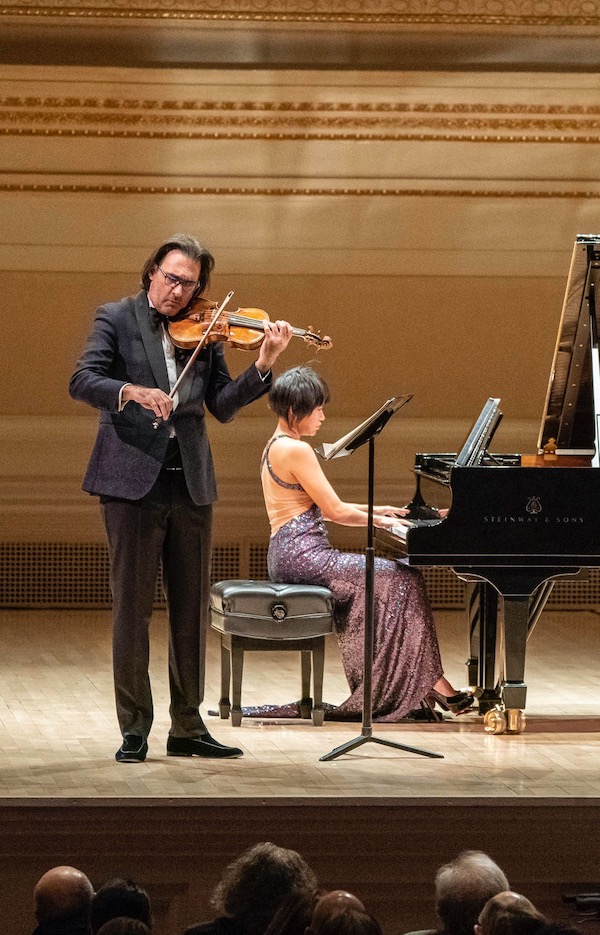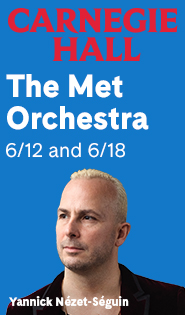After false start, Kavakos and Wang deliver a gripping, intense evening at Carnegie

Postponed from the 2019-2020 season, violinist Leonidas Kavakos is presenting his Perspectives Series at Carnegie Hall during the current season. The opening installment took place Thursday night in Stern Auditorium with Kavakos and pianist Yuja Wang playing violin sonatas from Bach, Ferruccio Busoni, and Shostakovich.
If there was a conceptual framework for this particular Perspective, it was Bach and his structural and formal legacy, as Busoni and Shostakovich both made use of contrapuntal forms in their Violin Sonata No. 2 in E minor, Op. 36a, and Op. 134 Violin Sonata, respectively.
The concept turned out to be thin, because though the concert ended with a great and sustained flourish, the opening Bach Violin Sonata No. 3 in E Major, BWV 1016, was astoundingly shaky, in a way that struck one as impossible for the caliber of these musicians. One wondered if they had not properly rehearsed, as the two seemed to be playing different pieces altogether, never meshing except for brief moments in the Adagio ma non tanto movement. But mostly, the performance sounded like Wang trying—fruitlessly—to create a steady pulse as a framework, while Kavakos wandered from note to note, with no clear direction. Even the fast 16th-notes of the final movement could not force the two together for any longer than an incidental moment.
This was baffling and frustrating, and compounded by a technical issue. Violin soloists in the concert hall commonly tune their instrument slightly sharp so as to cut through any accompanying music, but Kavakos was drastically out of tune with the piano. His sound was also surprisingly thin—at first one thought he was utilizing period performance practice ideas, but there was so much inconsistency that one eventually put it down to plain bad playing. That, along with a nearly 15-minute delay after the scheduled time, had one thinking the violinist was, for whatever reasons, just not ready to play.
Fortunately, all this changed with the performance of the Busoni Sonata, and that and the Shostakovich sonata were powerful, gripping experiences with playing that was not only technically polished but exploding with concentrated purpose, expressive force, and the feeling that something vital was being said.
The opening moments of the Busoni Sonata were inauspicious, but that wasn’t the musicians’ fault—someone’s phone rang as Wang played the hesitant opening pianissimo statement. But this performance was on an entirely different level than the Bach, and that was clear at the moment of Kavakos’ entrance—rendered with an interpretive and expressive unanimity that made absolute sense with the formal and psychological complexity of the music.
Complexity is the word for this piece, with long stretches of darkness and agitation clearing away. Like bright sunshine after a violent thunderstorm, the light wasn’t pure, instead reflecting off what sensations the previous music had left behind.
That balance is a feature of the first and third movements, which were gorgeous. The brief middle presto was vibrant enough that the audience respond with vocal accolade. Kavakos, who was segueing into the sustained E that begins the enormous final movement, smiled and held up his index finger, letting everyone know there was so much more to come. The finale is a quasi-symphonic journey in and of itself, expressive and lyrical to start, then moving through a series of knotty variations, before culminating in a fugue nearly hidden under a swooning melodic line. The pair built a level of intensity that pressed past the music, leaving the structural details behind for the sake of sheer expression.
The Shostakovich Violin Sonata was more controlled but no less intense. One of the deepest impressions of the piece was that, coming so soon after Wang playing the composer’s Piano Concerto No. 2 with the Philadelphia Orchestra at Carnegie Hall, it convinced one that Wang is one of the great Shostakovich players. The music seems to flow through her, and she understands that the simple material that the composer so often uses must be played with a combination of naivite and the infinite depths and complications of experience.
Kavakos played with a superb forward flow on top of this, carrying the tremendous mass of musical and emotional ideas in the notes. The middle Allegretto was excellent, the music pushing downward on the beats while also maintaining a sure forward momentum. In the finale, Kavakos played the pizzicato passages with an unreal dynamic level, a fortissimo that surpassed the Bartók “snap” technique but without any distortion. The hallmark of this performance was the power of meaning coming through every note and gesture, the quiet passages holding the intensity behind the music close to the vest, only to burst forth aggressively when the pressure becomes too much.
For an encore, Kavakos and Wang played the “Dithyrambe” from Stravinsky’s masterpiece, Duo Concertant. The music has a lean profile that conveys great aesthetic and expressive weight, and the intensity of the playing was poignant. It cleared away the complex ambiguities that came before and refreshed the senses, while deepening the marvelous impression that had come before.
Leonidas Kavakos plays Beethoven Piano Trios with Yo-Yo Ma and Emanuel Ax, 8 p.m., March 8, 2022. carnegiehall.org
